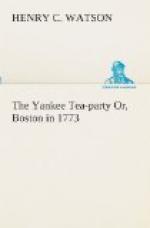“It served the ’tarnal rascals right,” observed Hanson. “They only reaped what they had sown. War’s a horrible matter, altogether, and I don’t like it much; but I like to see it done up in that old man’s style, if it is done at all.”
“I should like to have seen that royal officer that said he could march through our country with three regiments,” said Kinnison. “If he was with Smith and Pitcorn that day, he saw there was a little of the bulldog spirit in the Yankees.”
“I think,” observed Pitts, “we might have that old, heart-firing, arm-moving tune called Yankee Doodle. Come, Brown, pipe.”
“Ay,” replied Brown, “that tune came out of this here fife naturally—almost without my blowing it. For some time, I couldn’t work anything else out of it.”
“Come, pipe and drum the old tune once more,” cried Colson; and it was piped and drummed by Brown and Hanson in the real old continental style. The effect on the company was electric. Knives, and forks, and feet, kept time to the well-known music. Some of the old men could scarcely restrain themselves from attempting a cheer, and the young men felt themselves stirred by a feeling of patriotism they had scarcely known before. The spirit of 1775 dwelt in the music, and, as the quick notes started from fife and drum, visions of farmers leaving the plough in the furrow and shouldering the rusty and unbayoneted firelock—of citizens leaving their business and homes to grasp the sword and gun—of stout-hearted, strong-armed minute-men, untrained to war’s manoeuvres, marching and battling with the well-disciplined, war-schooled, and haughty Britons, made confident by a more than Roman career of victory—and of the glorious fight at Breed’s Hill—came to the minds of all present. Three cheers were given, when the musicians had concluded, for the tune itself, and three more for those who had played it.
“More ale,” called out Hand, and more ale was brought; and then Hand proposed as a toast—“The memory of the men who fell on the 19th of April, 1775.” This was drank standing, and a short pause ensued.
FIFER’S STORY.
“Now,” said Kinnison, “I expect that some of you men who know something about them times shall keep your promise of following my story.”
“I’ll tell you a story,” replied Brown, the fifer. “P’raps some of you won’t swallow it; but it’s all fact, and that you’ll find if you choose to hunt for the papers. It’s chiefly about me and my fife, and Hanson and his drum.”
“Pipe away, Brown,” said Kinnison.
“Well, you see,” began Brown, “Hanson and I were drummer and fifer in Colonel Brooks’ regiment, at Saratoga, and we were in the battle of Stillwater, fought on the nineteenth of September. I’m not going to ‘spin a yarn,’ as the sailors say, in the way of an account of that battle, for that has been said and sung often enough. It is sufficient for me to say, that it was the hardest




